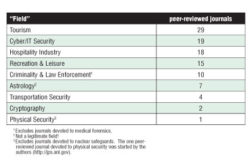Home » security research
Articles Tagged with ''security research''
Does Enterprise Physical Security Count as a ‘Real’ Field?
We define physical security as measures taken to protect tangible physical assets from harm.
May 1, 2014
Sign-up to receive top management & result-driven techniques in the industry.
Join over 20,000+ industry leaders who receive our premium content.
SIGN UP TODAY!Copyright ©2024. All Rights Reserved BNP Media.
Design, CMS, Hosting & Web Development :: ePublishing







